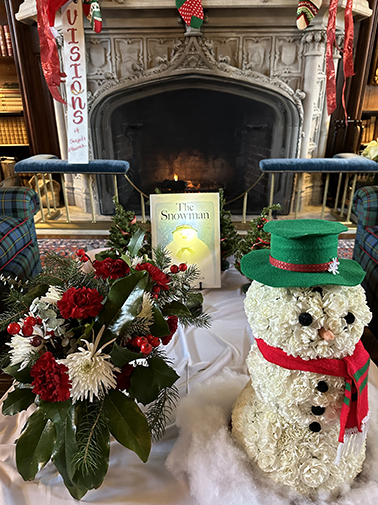
From Love Inc.
Remember when this dress premiered on the Eras Tour? We do! The custom Vivienne Westwood gown is filled with the lyrics from Track 10 of Tay’s 2024 album, The Tortured Poets Department. It inspired us to seek out more artists and designers who took literary fashion to the next level. So today we present Pop’s Top 10 literary gowns!
#1 GONNA BE GOLDEN

From Shelf Talker
Created by Ryan Jude Novelline, the artist stitched together the colorful illustrations from discarded Little Golden Books, and fashioned a bodice from the spines. If you’d like to read an interview about his amazing creation, please follow this link.

From The Literary Rapport
#2 BOOK WITCH

From Reddit
Posted on Reddit, the detailing on this dress is off the charts! Plus, the hat! The HAT.
#3 SUPER SEUSS

From Bored Panda
Created by Rebecca Humes, the Seuss-specific shredded tutu and bouncy book characters on springs is delightfully whimsical!
#4 DISNEY DANCER

From Bored Panda
Another dress by Rebecca Humes. But this one was created from Disney books and features a skirt composed of thousands of chain links. WOW!
#5 POTTER PROM

From Bored Panda
Hailey Skoch rustled her way to her Arkansas senior prom in a dress made from multiple volumes of Harry Potter books! You can read more about her process here.
#6 FANTASTIC FAIRY

From Ingrid’s Notes
Winner of cutest, most adorable wings and folded tutu is this phenomenal book fairy!
#7 VOLUMINOUS VOLUMES

From Faerie Magazine
This distinct dress with a colonial flare was created by White Knight Cosplay. And just look at that teacup broach!
#8 FAIRY TALE FASHIONISTA

From When I Grow Up
A stack of unwanted volumes transformed into a fairy tale worthy dress by Helen Hobden, who also entered it in a contest judged by Maisie Williams! Read more about her adventure here.
#9 BOUND TO IMPRESS

From For Reading Addicts
French designer Silvie Facon created this flowing masterpiece from old leather spines that had separated from books. It took 250 hours! More more extensive photos, plus more dresses, please follow this link.
#10 SHORT STORY

From For Reading Addicts
Silvie Facon also created this sassy little folded dress, again by only using books that were beyond repair. For more details, please see this link.
Feeling inspired but also maybe a tad overwhelmed by the sheer volume of talent? No worries! You can craft this simple origami newsprint dress by following the instructions here.

Pssst! We also made a Cinderella dress out of highly unusual materials! See that here.



 Nearby was a Nutcracker-inspired tree festooned with sweet little ballet ornaments:
Nearby was a Nutcracker-inspired tree festooned with sweet little ballet ornaments: At the next display, the West Trenton Garden Club stole my heart with this innovative white carnation snowman, aptly paired with Raymond Brigg’s classic The Snowman. Look that snowman’s little baby carrot nose. Perfection!
At the next display, the West Trenton Garden Club stole my heart with this innovative white carnation snowman, aptly paired with Raymond Brigg’s classic The Snowman. Look that snowman’s little baby carrot nose. Perfection!
 And a Mexican holiday legend retold and illustrated by Tomie dePaola. If you’re a fan of dePaola’s work, don’t miss
And a Mexican holiday legend retold and illustrated by Tomie dePaola. If you’re a fan of dePaola’s work, don’t miss 

 This next table is one of our absolutely favorites. Dr. Seuss’ The Grinch, which boasted a delightful sled bouquet in a decorated sack.
This next table is one of our absolutely favorites. Dr. Seuss’ The Grinch, which boasted a delightful sled bouquet in a decorated sack. And to the person who created a Grinch out of evergreen branches and a painted vase? You made our hearts grow three sizes larger. You deserve a gold medal for creativity, and I hope you don’t mind if I replicate this idea for my front porch next year? Incredible!
And to the person who created a Grinch out of evergreen branches and a painted vase? You made our hearts grow three sizes larger. You deserve a gold medal for creativity, and I hope you don’t mind if I replicate this idea for my front porch next year? Incredible! Finally we come to the grand finale, and this was just so touching and innovative. A table featuring Charles Dickens’ A Christmas Carol. The three ghosts are represented with delicate custom bouquets. I don’t know when or how, but we are going to do something with this idea in the future. It’s absolutely wonderful.
Finally we come to the grand finale, and this was just so touching and innovative. A table featuring Charles Dickens’ A Christmas Carol. The three ghosts are represented with delicate custom bouquets. I don’t know when or how, but we are going to do something with this idea in the future. It’s absolutely wonderful.
 We’ve had PLENTY of snow this winter, and the last storm to blow through resulted in an unexpectedly zany backyard colorscape! The blue and yellow snow mound you see above is a nod to the striped tower on the cover of Dr. Seuss’ book, Oh, The Places You’ll Go! (I couldn’t resist adding a smiley face too). And today is Dr. Seuss’ birthday, so it’s timely as well!
We’ve had PLENTY of snow this winter, and the last storm to blow through resulted in an unexpectedly zany backyard colorscape! The blue and yellow snow mound you see above is a nod to the striped tower on the cover of Dr. Seuss’ book, Oh, The Places You’ll Go! (I couldn’t resist adding a smiley face too). And today is Dr. Seuss’ birthday, so it’s timely as well!




